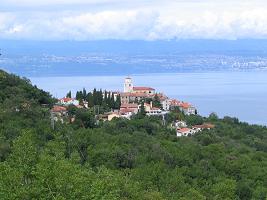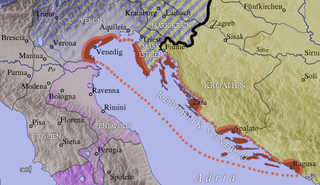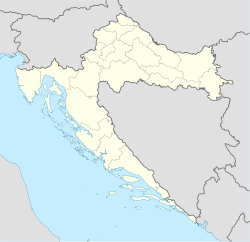
Istria is the largest peninsula to border the Adriatic Sea. Located at the top of the Adriatic between the Gulf of Trieste and the Kvarner Gulf, the peninsula is shared by three countries: Croatia, Slovenia, and Italy, 90% of its area being part of Croatia. Most of Croatian Istria is part of Istria County.

Roč is a village in Istria County, north-west Croatia. Administratively it belongs to the town of Buzet. Roč is considered a historic town rather than a village due to its rich cultural heritage.

Istria County is the westernmost county of Croatia which includes the majority of the Istrian peninsula.

Pula, also known as Pola, is the largest city in Istria County, Croatia, and the seventh-largest city in the country, situated at the southern tip of the Istrian peninsula in northwestern Croatia, with a population of 52,220 in 2021. It is known for its multitude of ancient Roman buildings, the most famous of which is the Pula Arena, one of the best preserved Roman amphitheaters. The city has a long tradition of wine making, fishing, shipbuilding, and tourism. It was the administrative centre of Istria from ancient Roman times until superseded by Pazin in 1991.

Pazin is a town in western Croatia, the administrative seat of Istria County. It is known for the medieval Pazin Castle, the former residence of the Istrian margraves.

Piran is a town in southwestern Slovenia on the Gulf of Piran on the Adriatic Sea. It is one of the three major towns of Slovenian Istria. The town is known for its medieval architecture, with narrow streets and compact houses. Piran is the administrative seat of the Municipality of Piran and one of Slovenia's major tourist attractions.

The Julian March, also called Julian Venetia, is an area of southern Central Europe which is currently divided among Croatia, Italy, and Slovenia. The term was coined in 1863 by the Italian linguist Graziadio Isaia Ascoli, a native of the area, to demonstrate that the Austrian Littoral, Veneto, Friuli, and Trentino shared a common Italian linguistic identity. Ascoli emphasized the Augustan partition of Roman Italy at the beginning of the Empire, when Venetia et Histria was Regio X.

The Austrian Littoral was a crown land (Kronland) of the Austrian Empire, established in 1849. It consisted of three regions: the Margraviate of Istria in the south, Gorizia and Gradisca in the north, and the Imperial Free City of Trieste in the middle. The region has been contested frequently, with parts of it controlled at various times by the Republic of Venice, Austria-Hungary, Italy, and Yugoslavia among others.

Grožnjan is a settlement and municipality in Croatia. It is part of Croatia's Istria County, which takes up most of the Istrian peninsula. 39% of the municipality's population is Italian.

Kršan is a village and municipality in the eastern part of Istria County, Croatia.

Pićan is a village and municipality in the central part of Istria, Croatia, 12 km southeast of Pazin; elevation 360 m. The chief occupations are agriculture and livestock breeding. It is situated on the D64 state road (Pazin-Kršan-Vozilići). There is a railway station on the former Lupoglav – Raša railway.

Mošćenice is a village in the municipality of Mošćenička Draga in Primorje-Gorski Kotar County on the Istrian peninsula, close to Opatija, Croatia.

The March of Istria was originally a Carolingian frontier march covering the Istrian peninsula and surrounding territory conquered by Charlemagne's son Pepin of Italy in 789. After 1364, it was the Istrian province of the Habsburg monarchy, the Austrian Empire and Austria-Hungary.

The Raša in Croatian Istria is a major river of Croatia's Istria County. It is 23 kilometres (14 mi) long, and its basin covers an area of 279 km2 (108 sq mi). Its mouth is in the long ria of Raša Bay, which is a drowned river valley scoured out when world sea levels fell, then drowned by the rising waters of the post-glacial era. The Raša rises in springs near Pićan and flows south through a steep-sided valley before opening into the head of the Adriatic Sea. The river, although short in length, has an ancient history as a border.

Istrian Italians are an ethnic group from the Adriatic region of Istria in modern northwestern Croatia and southwestern Slovenia. Istrian Italians descend from the original Latinized population of Roman Histria, from the Venetian-speaking settlers who colonized the region during the time of the Republic of Venice, and from the local Croatian people who culturally assimilated.

Slovene Istria is a region in southwest Slovenia. It comprises the northern part of the Istrian peninsula, and is part of the wider geographical-historical region known as the Slovene Littoral. Its largest urban center is Koper. Other large settlements are Izola, Piran, and Portorož. The entire region has around 120 settlements. In its coastal area, both Slovene and Italian are official languages.

Istria is the largest peninsula in the Adriatic Sea. The peninsula is located at the head of the Adriatic between the Gulf of Trieste and the Bay of Kvarner. It is shared by three countries: Croatia, Slovenia, and Italy.

Labinština is the geographical and historical name of the eastern part of Istria county in Croatia. It covers an area of approximately 220 km2 that is 25 km long and 13 km wide. Geographical borders in the west are the Raša river, and the bay of the same name, in the south and east the sea, and in the north Plomin Bay, the southern part of the Učka massif and Kvarner Bay, and, until the beginning of the 20th century, Lake Čepić. The center is Labin after which it is named. Labin was the head township of the Labinština or Agro Albonese under the Roman Empire, during the Venice Republic between 1365 and 1797, the Austrian rule between 1814-1918 and many other occupations by foreign armies.
Šime Kurelić was a Croatian politician from Pićan and a revivalist of Croatian nationalism among Istrian Croats.

Borut is a village in Istria, Croatia. The name Borut or Borutto is the common name for several small villages and hamlets: Budaki, Buzići, Čuleti, Dausi, Grdinići, Grgurići, Moloni, Orlovići, Poljanice and Sandalji. When Istria was part of the Kingdom of Italy, the village was called Borutto di Bogliuno which was located in the Province of Pola.



























